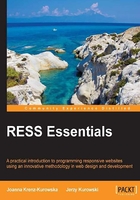
Summary>
The RESS idea can be described as Server Side optimizing page components for devices with the use of browser-features detection. In other words, RESS is an attempt to marry client-side responsive design achieved by using media queries and some JavaScript with Server Side logic. The purpose here is to make the whole system more efficient, and to overcome the constraints of a client-side application. These are vague statements and we need to be more precise before we can build any actual RESS systems. To know what RESS can do for us we have to know what problems we need to address and what Server Side infrastructure we have in place. RESS solutions are most often employed just for image optimization, but you could use it for serving the 3D Web GL version for those who can use it, FLASH for those who have it, CSS animations for those who see it, and so on.
The most underestimated RWD advantage is that it allows us to make better designs: designs that always use all the available screen width. This is the case for the first time since the very beginning of the Internet. The old way of making fluid layouts was a flawed solution that never grew out of childhood diseases. In the following chapter, we will build a really simple RWD example based on the HTML5 Boilerplate, using a responsive navigation component from H5BP (HTML5 Boilerplate). We will not use the default grid system but replace it with one that we define ourselves with the Gridpak service.